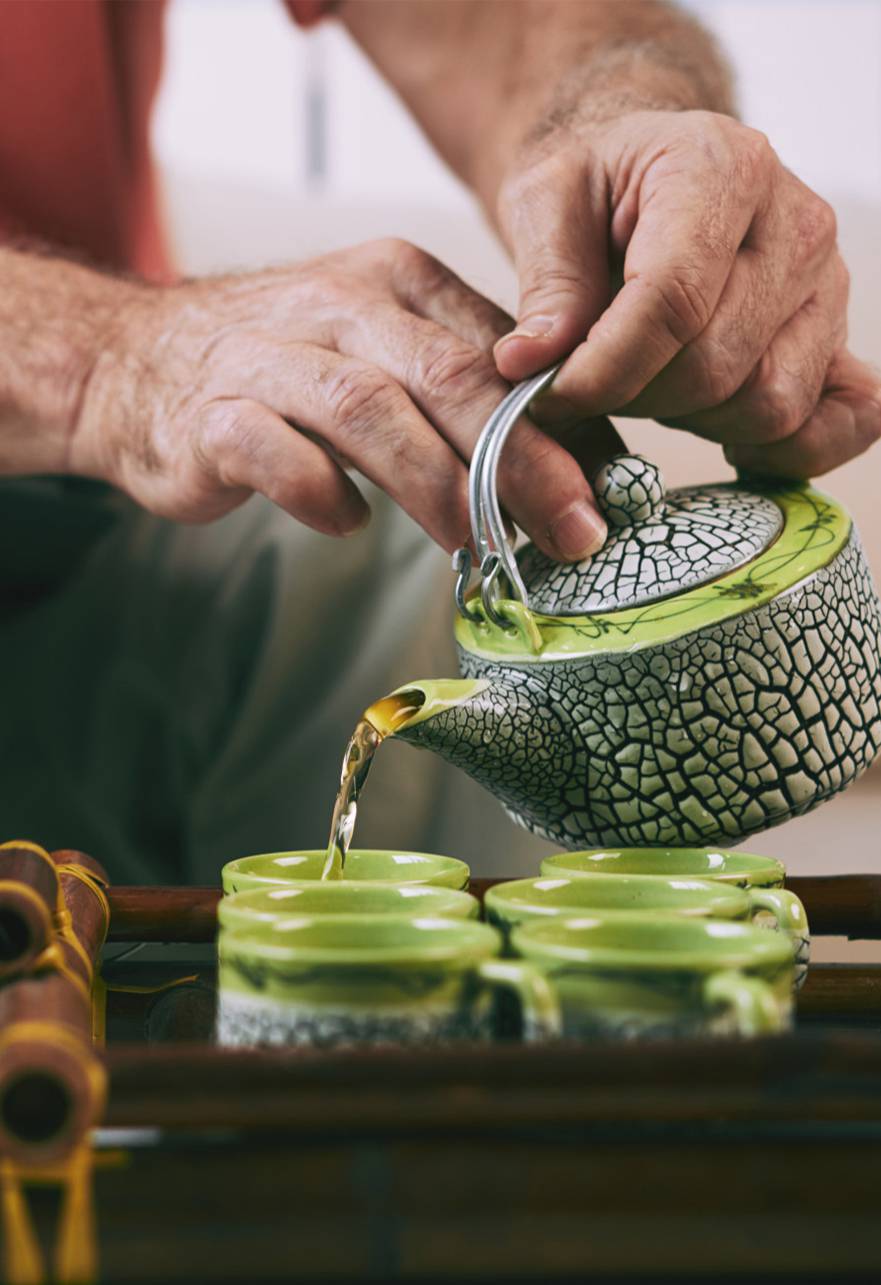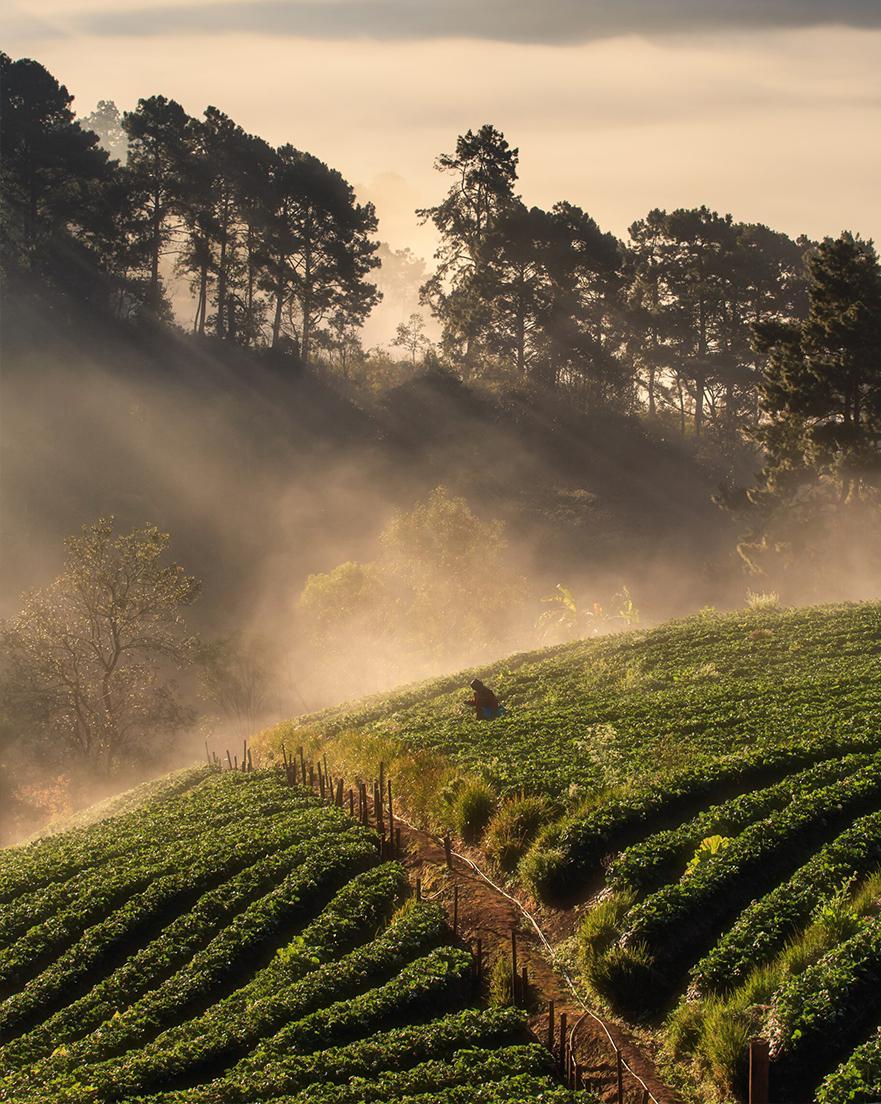Aromatic and mild Chinese tea with a slightly bitter infusion
Discover our other origin teas:
Iconic and popular, Chinese tea has become the most consumed beverage in the world after water. As the cradle of tea culture, China, the world's leading producer, offers an exceptional wide variety of green, white, black, oolong and Pu Erh teas, each with its own characteristics. From the Tang and Ming dynasties to modern times, the art of tea has been perfected to offer infusions with unique flavors, from intense vegetal notes to woody and fruity aromas. Discover the finest teas from the renowned provinces of Yunnan, Fujian, and Zhejiang, where climate and traditional tea production methods ensure high quality. Indulge in the famous jasmine teas, dark Pu Erh and fragrant oolongs.
Pu Erh Mini Tuo Cha pressed into small bird's nest shapes
Transform the winter cold into a moment of comfort with our festive teas, herbal teas, and rooibos.
DiscoverChinese tea rolled into small pearls used for mint tea
Aromatic and very mild Chinese tea. Light and refreshing.
High-quality white tea, floral and mild with a fragrant liquor
Flavored with fine and rare bergamot! A great classic
Chinese green tea known for its hazelnut flavor and fresh...
Rare green tea with fruity, sweet, and slightly tangy taste
Rare green tea from the Zhejiang region in China
Very pleasant morning tea that can be enjoyed with milk
Rare jasmine tea, light and flavorful, offering a golden...
Smoked black tea with special woods, strong aromatic power

A millennial treasure of Chinese culture, Chinese tea fascinates with its mysteries and subtleties. Born from the precious leaves of Camellia sinensis, it has enchanted the taste buds of tea lovers worldwide for over 5000 years. From the morning mists of the Yunnan mountains to the verdant gardens of Fujian, each terroir tells a unique story through its aromas.
The history of tea is rooted in Chinese culture since prehistoric times. The country, recognized as the true cradle of tea culture, has forged a rich tradition around this millennial beverage. The legend of Emperor Shennong, a mythical figure in Chinese medicine, tells how he accidentally discovered the virtues of tea in 2737 BC, when tea leaves fell into his boiling water.
During the Tang Dynasty (618-907), the art of tea experienced its first golden age with the publication of the "Classic of Tea" by Lu Yu, the first treatise entirely devoted to this drink. This period marked the beginning of its spread throughout Asia. The Song Dynasty (960-1279) further refined tea culture, developing elaborate ceremonies and establishing the first tea houses, transforming tea consumption into a refined way of life. From poets to merchants, from monks to emperors of the Ming Dynasty, up to the 19th century, each contributed to enriching this unique cultural heritage.
The consumption of tea is part of a thousand-year-old tradition of well-being. 20th century manuscripts rediscover what the ancient physicians of the Imperial Court already knew: the tea base holds treasures for health. The tea gardens of Anhui province, cradled by morning mists, produce leaves particularly rich in antioxidants. Recognized for its power to broaden the mind and its beneficial effect on the body, Chinese tea is a true treasure of benefits. The cultivation of tea at high altitudes, where pure air and mineral soil create ideal conditions, gives birth to exceptional varieties that promote concentration and elevate mood. The rare yellow tea, once reserved for emperors, is particularly prized for its powerful antioxidant properties.
From the plantations of Sri Lanka to the millennial Chinese terraces, tea masters have identified certain slimming varieties with remarkable metabolic properties. A large part of modern studies confirms these ancestral observations, particularly for aged teas and high mountain oolongs, which naturally support weight management.

The People's Republic of China, the world's leading producer, offers a wide variety of teas, each with its own aromatic signature. From Yunnan to the northern Fujian, each region cultivates unique varieties adapted to their particular terroir.
Chinese green tea represents excellence in tea production. The famous Long Jing, also known as Dragon Well, captivates with its vegetal notes and refreshing character. Its highest quality comes from the Zhejiang province, where the climate and altitude give the tea leaves their distinctive flavor.
Black tea, called red tea in China, includes the prestigious Lapsang Souchong, with its characteristic smoky notes. This category, the result of complete oxidation, develops intense aromas that evolve in the tea cup.
Chinese oolong tea holds a special place in the tasting guide. The Bai Hao, semi-oxidized, reveals floral fragrances of high quality. These teas, cultivated particularly in Hong Kong and Taiwan, require ancestral expertise.
White tea, including the famous Bai Mu Dan with its characteristic white down, represents the quintessence of delicacy. Its minimal processing preserves the natural properties of the tea plant, offering a subtle liquor with spring notes.
Pu Erh tea comes in two categories: green puerh tea and dark puerh tea. These fermented teas, often pressed into cakes, develop complex aromas reminiscent of forest floor. Some productions dating from Huang 2000 reach remarkable prices.
Among the jewels of Chinese production, several teas stand out for their exceptional renown and unique character.
The legendary Dragon Well tea, whose Chinese name is Long Jing, embodies the excellence of Chinese green tea. Its history dates back to the Ming dynasty, and its flat, shiny leaves release delicate notes of fresh chestnuts and orchids. Its production, limited to a few hills in Zhejiang, follows a rigorous schedule dictated by spring rains.
Yunnan tea, grown in the misty mountains of the Southwest, is renowned for its richness and malty notes. The delicate jasmine tea, naturally scented with fresh flowers, represents the art of Chinese scented tea. Smoked black tea, with its characteristic woody notes, evokes the caravans of the Tea Route.
Gunpowder green tea, whose leaves are rolled into small pellets resembling gunpowder, offers a lively and refreshing liquor. The refined Bai Mu Dan tea, an exceptional white tea, is distinguished by its smoothness and floral notes. Finally, the precious Tie Guan Yin tea, a renowned oolong, owes its name to the Goddess of Mercy and reveals complex aromas of orchid and ripe fruits.
The vertiginous cliffs of the Wuyi Mountains shelter the six ancestral tea trees that gave birth to this mythical tea. Legend has it that an emperor was cured by this tea and offered his red cloak (hong pao) to protect the precious shrubs from frost. This oolong tea develops complex aromas of ripe fruits, roasted flowers, and minerals.
Preserving the aromas requires specific conditions. Light, humidity, and temperature must be controlled to maintain the integrity of the leaves and their aromatic potential.
To prepare a perfect Chinese tea, every detail matters. Start by warming your teapot with hot water to preheat it. The ideal amount of tea leaves is generally one teaspoon per cup, but this can vary depending on the type of tea. To brew correctly, respect the specific temperature and steeping time for each variety. Steeping for too long can make the tea bitter, while too short an infusion won't release all the aromas. Then pour gently into your tea cup to fully appreciate the flavors.
Tea in China transcends mere beverage to become an ancestral art. Each province perpetuates its traditions, inherited from the Qing dynasty, thus enriching the heritage of the tea classic.
This ancient practice requires specific utensils and precise gestures. Jasmine tea, particularly appreciated during these ceremonies, reveals its floral aromas through meticulous preparation. The water, heated gradually, releases flavors in stages.
Traditional preparation requires specific instruments, each playing a crucial role in extracting flavors. Yixing clay teapots, true treasures of tea production, become impregnated over time with sublimated aromas.
China as a global producer offers exceptional diversity. Quality depends on multiple factors, from growing conditions to processing methods.
Each terroir confers unique characteristics. The Fujian plantations, historical cradle of many varieties, benefit from an ideal microclimate for developing the most subtle aromas.
Discover our other origin teas: